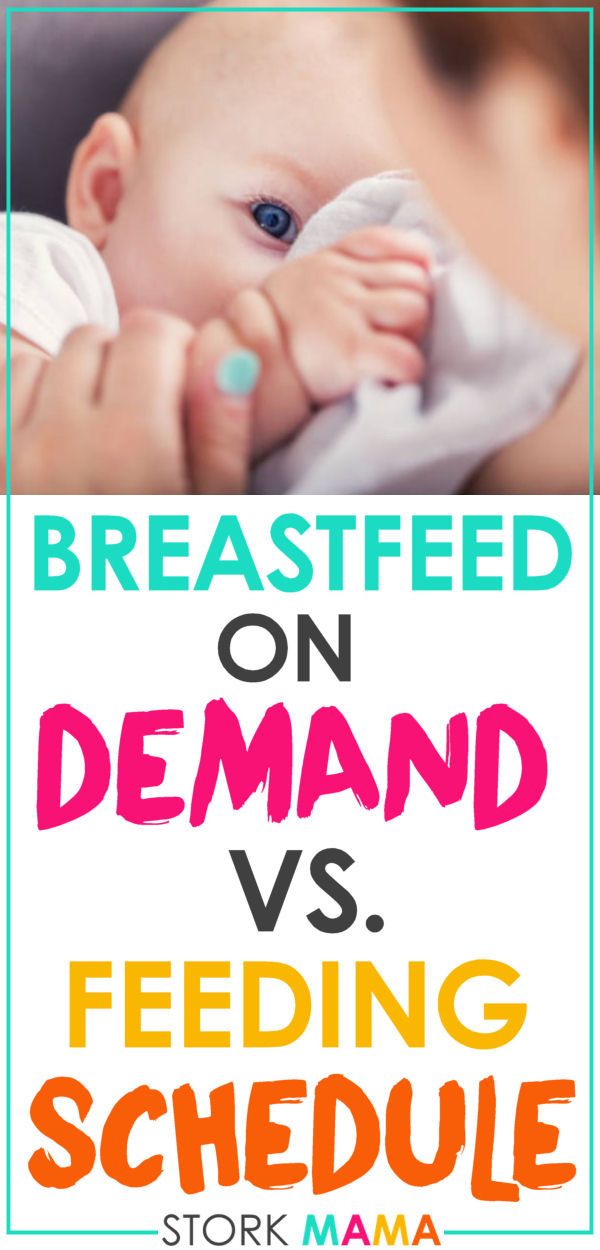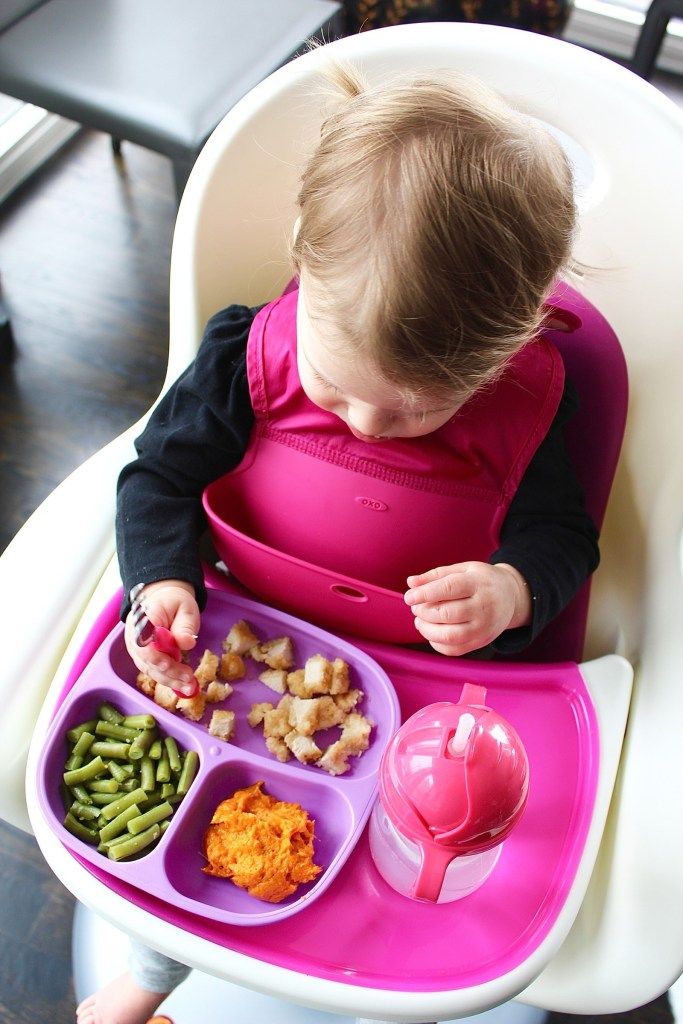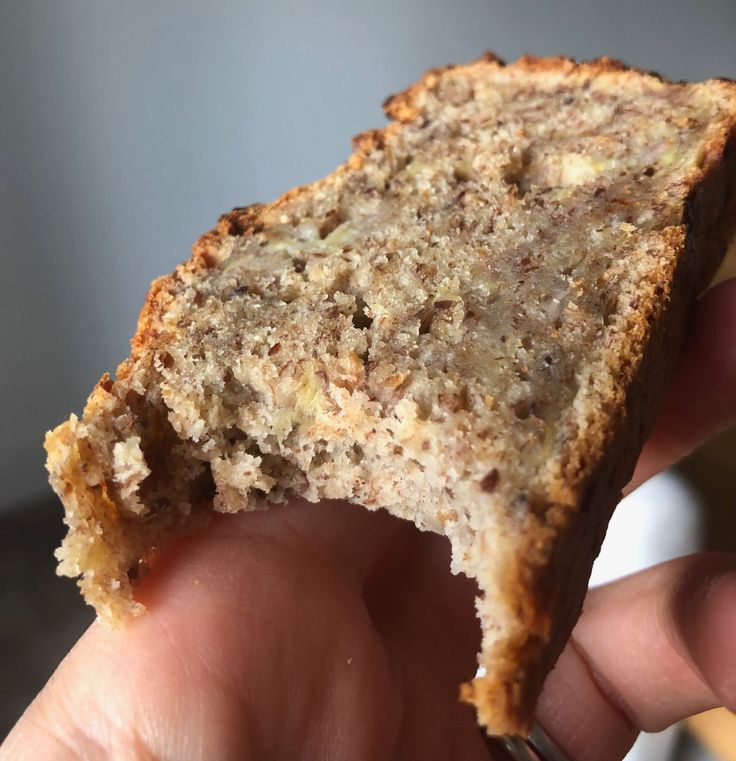Healthy feeding babies
Feeding Your 4- to 7-Month-Old (for Parents)
Most babies this age are ready to try solid foods. Experts recommend starting solid foods when a baby is about 6 months old, depending on the baby's readiness and nutritional needs.
Be sure to check with your doctor before giving any solid foods.
Is My Baby Ready to Eat Solid Foods?
How can you tell if your baby is ready for solids? Here are a few hints:
- Does your baby swallow food or push it out of their mouth? Babies have a natural tongue-thrust reflex that pushes food back out. Wait until this reflex disappears (typically when babies are 4–6 months old).
- Can your baby support their own head? To eat solid food, an infant needs good head and neck control and should be able to sit up.
- Is your baby interested in food? Babies who stare, reach and grab, and open their mouths for food are ready to try solid foods.
If your doctor gives the go-ahead but your baby seems frustrated or uninterested in solid foods, try waiting a few days before trying again. Breast milk and formula will still meet nutritional needs as your baby learns to eat solid foods. But after 6 months, babies need the added nutrition — like iron and zinc — that solid foods provide.
Do not add cereal or other food to your baby's bottle because it can lead to too much weight gain.
Watch for signs that your child is hungry or full. Respond to these cues and let your child stop when full. A child who is full may suck with less enthusiasm, stop, or turn away from the breast or the bottle. With solid foods, they may turn away, refuse to open their mouth, or spit the food out.
How Should I Start Feeding My Baby Solid Foods?
When your baby is ready and the doctor says it’s OK to try solid foods, pick a time of day when your baby is not tired or cranky. You want your baby to be a little hungry, but not so hungry that they’re upset. So you might want to give your baby a little breast milk or formula first.
Have your baby sit supported in your lap or in a high chair with a safety strap.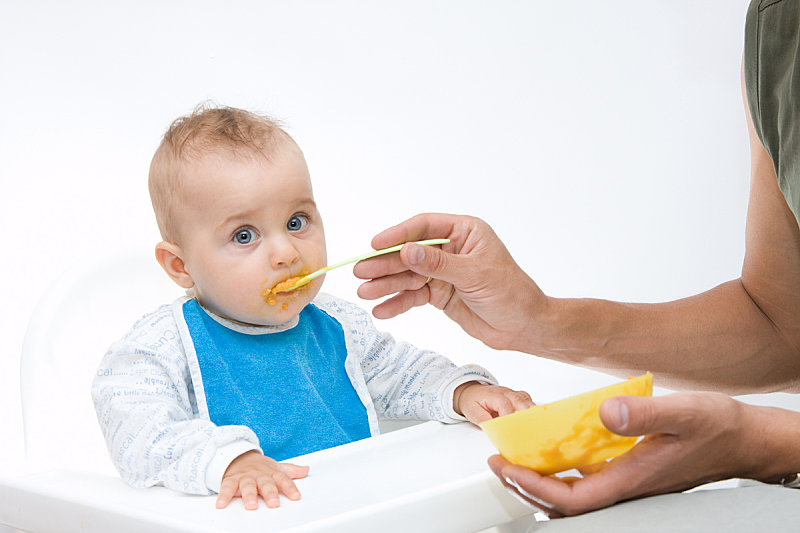
Most babies' first food is iron-fortified infant single-grain cereal mixed with breast milk or formula. Place the spoon near your baby's lips, and let the baby smell and taste it. Don't be surprised if this first spoonful is rejected. Wait a minute and try again. Most food offered to your baby at this age will end up on the baby's chin, bib, or high-chair tray. Again, this is just an introduction.
When your little one gets the hang of eating cereal off a spoon, it may be time to try single-ingredient puréed meat, vegetables, or fruit. The order in which you give them doesn't matter, but go slow. Offer foods that are high in iron and zinc — such as meat, poultry, eggs, and beans — especially if your baby is breastfeeding. Try one food at a time and wait several days before trying something else new. This will let you identify any foods that your baby may be allergic to.
Which Foods Should I Avoid?
Foods that are more likely to cause allergies can be among the foods you introduce to your baby. These include peanuts, eggs, cow’s milk, seafood, nuts, wheat, and soy. Waiting to start these foods does not prevent food allergies. Talk to your doctor if you’re concerned about food allergies, especially if any close family members have allergies, food allergies, or allergy-related conditions, like eczema or asthma.
These include peanuts, eggs, cow’s milk, seafood, nuts, wheat, and soy. Waiting to start these foods does not prevent food allergies. Talk to your doctor if you’re concerned about food allergies, especially if any close family members have allergies, food allergies, or allergy-related conditions, like eczema or asthma.
Infants with severe eczema or egg allergies are more likely to have allergies to peanuts. Talk to your doctor about how and when to introduce these foods to your child.
Possible signs of food allergy or allergic reactions include:
- rash
- bloating or an increase in gassiness
- diarrhea
- vomiting
Get medical care right away if your baby has a more severe allergic reaction, like hives, drooling, wheezing, or trouble breathing.
If your child has any type of reaction to a food, don't offer that food again until you talk with your doctor.
Babies shouldn't have:
- foods with added sugars and no-calorie sweeteners
- high-sodium foods
- honey, until after the first birthday.
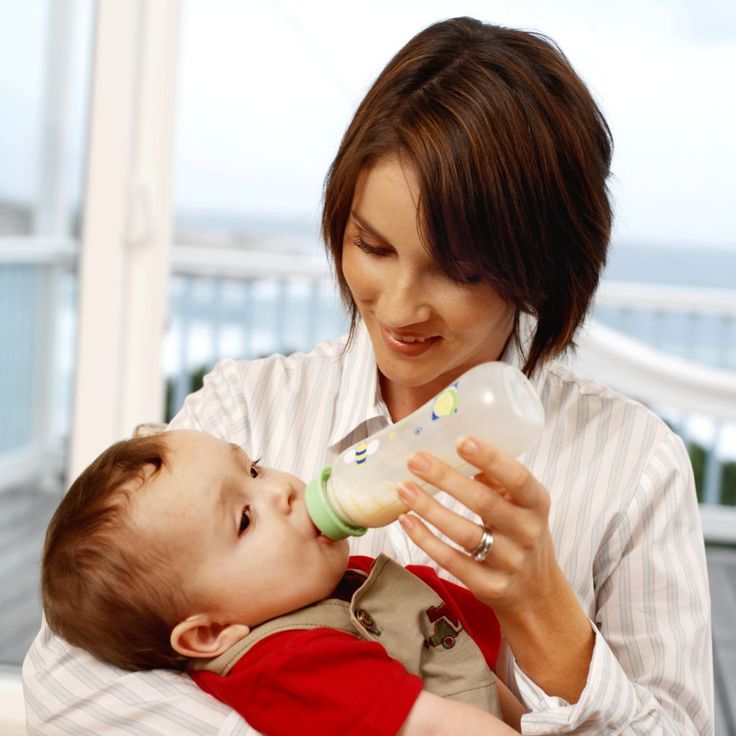 It can cause botulism in babies.
It can cause botulism in babies. - unpasteurized juice, milk, yogurt, or cheese
- regular cow's milk or soy beverages before 12 months instead of breast milk or formula. It’s OK to offer pasteurized yogurt and cheese.
- foods that may cause choking, such as hot dogs, raw carrots, grapes, popcorn, and nuts
Tips for Feeding Your Baby Solid Foods
With the hectic pace of family life, most parents try commercially prepared baby foods at first. They come in small, convenient containers, and manufacturers must meet strict safety and nutrition guidelines.
If you prepare your own baby foods at home, here are some things to keep in mind:
- Follow the rules for food safety, including washing your hands well and often.
- To preserve the nutrients in your baby's food, cook it in ways that keep the most vitamins and minerals. Try steaming or baking fruits and vegetables instead of boiling, which washes away the nutrients.
- Freeze portions that you aren't going to use right away.

- Whether you buy the baby food or make it yourself, texture and consistency are important. At first, babies should have finely puréed single-ingredient foods. (Just applesauce, for example, not apples and pears mixed together.)
- After your baby is eating individual foods, it's OK to offer a puréed mix of two foods. As babies get older, they will learn to eat a greater variety of tastes and textures.
- If you use prepared baby food in jars, spoon some of the food into a bowl to feed your baby. Do not feed your baby right from the jar — bacteria from the baby's mouth can contaminate the remaining food. If you refrigerate opened jars of baby food, it's best to throw away anything not eaten within a day or two.
- Around 6 months of age is a good time for your baby to try a cup. You might need to try a few cups to find one that works for your child. Use water at first to avoid messy clean-ups. Do not give juice to infants younger than 12 months.
Over the next few months, introduce a variety of foods from all the food groups. If your baby doesn't seem to like something, don’t give up. It can take 8 to 10 tries or more before babies learn to like new foods.
If your baby doesn't seem to like something, don’t give up. It can take 8 to 10 tries or more before babies learn to like new foods.
Your Baby's Growth: 4 Months (for Parents)
Babies this age continue to grow — in size, physical skills, and their ability to interact with the world.
Many of the new skills they're learning will come in handy for eating solid food. In fact, some time over the next few months, your baby may get that first taste of food beyond breast milk or formula. Although breast milk or formula will continue to be the main source of nourishment, your baby can start to explore different tastes and textures.
As long as your baby continues to grow steadily, eating habits shouldn't be a cause for concern. Your baby will be ready to start eating puréed foods when she can sit well without need for support and has lost the tongue-thrust reflex (pushing solids out of the mouth with the tongue).
How Much Will My Baby Grow?
By 4 months, many babies have doubled their birth weight. This month, babies gain about 1 to 1¼ pounds (560 grams) and about 0.8 inches (2 centimeters) in length.
This month, babies gain about 1 to 1¼ pounds (560 grams) and about 0.8 inches (2 centimeters) in length.
Since your child's birth, the doctor has been recording growth in weight, length, and head size (circumference) during your regular well-baby visits. The doctor tracks these numbers on standard growth charts. Ask your doctor to show you your baby's growth record. By now, you should begin to see a personal growth curve emerging — expect your child to continue growing along this curve.
Should I Be Concerned?
Is my baby big enough? Is my child destined to be tall or short? Parents often worry about growth and may compare a baby with siblings and peers. It's important to remember that kids come in a wide range of shapes and sizes.
Growth depends on many factors, including:
- genes passed on by the parents (kids tend to resemble their parents in height)
- the amount and quality of food a child eats
- overall health
- the functioning of the hormones that control growth
Based on the growth chart, the doctor can determine whether your child is growing as expected. If at any time you're concerned about your baby's weight or growth in general, discuss your worries with your doctor.
If at any time you're concerned about your baby's weight or growth in general, discuss your worries with your doctor.
In response to your concerns, the doctor may ask you these questions:
- How many feedings a day does your baby get?
- How much does your baby eat at each feeding?
- How long does a breastfeeding baby nurse at each feeding?
- What else are you feeding your baby?
- How frequent are your baby's bowel movements? What do they look like?
- How often does your baby pee?
The doctor also may ask questions about your baby's health and development. All these things together will help the doctor decide if your baby is growing at an appropriate rate. The doctor may recommend tests if he or she thinks there may be a problem that needs to be addressed.
Premature babies may still be behind in size compared with their full-term peers, but they should also be growing steadily at their own rate.
What About the Chubby Baby?
With all the concern about childhood obesity, parents may worry that their baby is getting too fat. A few babies and toddlers are overweight. For these children, advice from the baby's doctor can be useful.
A few babies and toddlers are overweight. For these children, advice from the baby's doctor can be useful.
Never withhold food from a baby in an attempt to cause weight loss. To grow and develop as they should, babies need proper nutrition, including fat, in their diet. For the first year, breast milk or formula should continue to be their main source of nourishment.
It's safe to introduce solid foods at around 6 months for breastfed and formula-fed babies. When the time is right, start with a single-grain cereal for babies (rice cereal has traditionally been the first food for babies). Then introduce other foods, such as puréed fruits and vegetables. Your doctor can advise you on how much of each food to give, but pay close attention to your baby's cues that he or she has had enough.
What's Next?
Your baby's rapid growth will start to slow down during the second half of the first year. But expect big changes in the coming months as your baby becomes more mobile.
Reviewed by: Cristy A. Wong, MD
Date reviewed: January 2019
Breastfeeding - the health of your baby.
Breastfeeding is the health of your baby.
The son fell asleep, trustingly and gently
Pressing her cheek against her mother's chest,
And we fly, as in space boundless,
Like two stars in the milky way
At the beginning of life, what is needed for the crumbs
To be with your beloved mother, and it's so easy
Always ready, tasty, close, near,
An invaluable gift is breast milk.
Sleep, my angel, and let you dream
Seas and mountains, stars, clouds
You can't stay small forever
You will become strong, brave, but for now
The Milky Way will give us serenity
Let every crumb be familiar with him
And he will be fed with a gentle smile
Great mother's milk!
Throughout the existence of mankind, breastfeeding newborns ensured the survival and health of the child. The rapid development of science, the involvement of women in public life, the early exit of a nursing mother to work led to the creation of a whole new industry, the "technology" of artificial feeding. The basis was based on a quantitative approach, the main indicator of nutritional adequacy was the increase in body weight and the amount of food consumed. If the child did not gain enough body weight and did not suck out the prescribed amount of milk in a strictly regulated feeding time, a diagnosis of hypogalactia was made and supplementary feeding from a bottle was prescribed. Replaced breast milk with cow's milk (all milk formulas with cow's or goat's milk), replaced mother's breasts with nipples and pacifiers. This approach was ubiquitous. The number of women breastfeeding has steadily declined. Recent studies have convincingly shown that the deterioration of the health of the child population - an increase in allergic, gastroenterological and nephrological problems, a decrease in the level of physical and mental development, is directly related to an increase in the number of children who are bottle-fed.
The rapid development of science, the involvement of women in public life, the early exit of a nursing mother to work led to the creation of a whole new industry, the "technology" of artificial feeding. The basis was based on a quantitative approach, the main indicator of nutritional adequacy was the increase in body weight and the amount of food consumed. If the child did not gain enough body weight and did not suck out the prescribed amount of milk in a strictly regulated feeding time, a diagnosis of hypogalactia was made and supplementary feeding from a bottle was prescribed. Replaced breast milk with cow's milk (all milk formulas with cow's or goat's milk), replaced mother's breasts with nipples and pacifiers. This approach was ubiquitous. The number of women breastfeeding has steadily declined. Recent studies have convincingly shown that the deterioration of the health of the child population - an increase in allergic, gastroenterological and nephrological problems, a decrease in the level of physical and mental development, is directly related to an increase in the number of children who are bottle-fed. Luckily for babies, mothers are returning to a natural and evolutionary way of organizing feeding - baby-friendly feeding. For the full development and formation of health in children, breastfeeding is necessary. The right of the child to breastfeeding was declared and enshrined in the Universal Declaration of the Rights of the Child.
Luckily for babies, mothers are returning to a natural and evolutionary way of organizing feeding - baby-friendly feeding. For the full development and formation of health in children, breastfeeding is necessary. The right of the child to breastfeeding was declared and enshrined in the Universal Declaration of the Rights of the Child.
Breastfeeding is the best way to keep your baby healthy for years to come.
Today, the physiology of infants and their mysterious baby soul is increasingly attracting the attention of psychologists, doctors and other specialists. It was possible to identify and describe the needs of the little man. They are conditionally divided into physiological and mental: the need for physical contact with the mother, the need for warmth, satiety, comfort, security, incessant care and love, deep emotional contact with the mother, the need for a variety of sensations and impressions. Moreover, the younger the child, the more needs are satisfied by sucking mother's milk. Ideally, the baby should not cry at all - after all, the mother has breasts for sucking and hands to comfort and eliminate the cause of discomfort. The composition of milk includes more than 400 components that guarantee the normal development of the child's body, and the opportunity to receive it gives a timely response to ANY need of the baby: drink, eat, fall asleep, calm down and be comforted, digest a lot of milk, release gas, normalize the intestinal microflora, recover, provide active work of the growing brain, regulate the activity of the nervous system and much more! This is how boundless the dependence of the health and development of the baby on receiving the necessary portion of milk on time to meet its vital needs.
Ideally, the baby should not cry at all - after all, the mother has breasts for sucking and hands to comfort and eliminate the cause of discomfort. The composition of milk includes more than 400 components that guarantee the normal development of the child's body, and the opportunity to receive it gives a timely response to ANY need of the baby: drink, eat, fall asleep, calm down and be comforted, digest a lot of milk, release gas, normalize the intestinal microflora, recover, provide active work of the growing brain, regulate the activity of the nervous system and much more! This is how boundless the dependence of the health and development of the baby on receiving the necessary portion of milk on time to meet its vital needs.
How exactly do babies ask for breasts? Don't expect demanding lamentations trying to justify the "on demand" name. Offer the breast at the FIRST signs of anxiety. As a rule, this is enough to prevent crumbs from upset. The newborn shows a desire to receive mother's milk, opening his mouth wide, turning his head in search of a nipple, grunting, whimpering, trying to suck a fist or edge of clothing.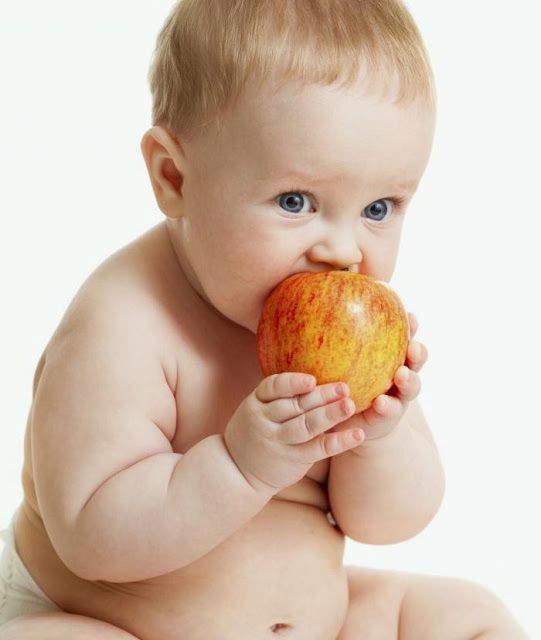 An older baby can already express himself more specifically: with gestures, movements, interjections, words.
An older baby can already express himself more specifically: with gestures, movements, interjections, words.
The general rule for establishing on-demand feedings is to put the baby to the breast in response to any discomfort. And then it will become clear what exactly he wanted - to quench his thirst or hunger, fall asleep, pee, change position, warm up. Or he just got bored alone. The kid calmed down, the mother eliminated the cause of discomfort - and you can continue to live calmly and cheerfully!
Attention!
The very concept of "feeding on demand" excludes the possibility of replacing the breast with a dummy or bottle. If the mother uses these items, then it is correct to say that the mother feeds according to the regime, introducing restrictions on the baby's access to the breast.
One of the reasons that violate the physiology of breastfeeding is the late start of breastfeeding. It seems to many mothers that on the first day she has no milk and the baby is crying from hunger. Meanwhile, the volume of the stomach in a newborn is only 2.0 ml. And those drops of colostrum are enough so that the child does not experience hunger. If a child would need large volumes of liquid immediately after birth, then nature would arrange the woman so that she would be flooded with colostrum immediately after childbirth. And in the first hours of life, a child may worry simply because he was born, and childbirth for a baby is the most stressful thing in life. Therefore, he is looking for his mother, breast sucking and the closeness of his mother soothe the child and he feels that he is loved and not alone in this big world.
Meanwhile, the volume of the stomach in a newborn is only 2.0 ml. And those drops of colostrum are enough so that the child does not experience hunger. If a child would need large volumes of liquid immediately after birth, then nature would arrange the woman so that she would be flooded with colostrum immediately after childbirth. And in the first hours of life, a child may worry simply because he was born, and childbirth for a baby is the most stressful thing in life. Therefore, he is looking for his mother, breast sucking and the closeness of his mother soothe the child and he feels that he is loved and not alone in this big world.
It is very important that the child receives colostrum. Colostrum contains more protein than mature milk. All immune factors, as well as colostrum leukocytes, provide the first protection of the child and prevent infectious and inflammatory diseases. Colostrum has a mild laxative effect, as a result of which the child's intestines are cleared of meconium (original feces), which reduces the duration of physiological jaundice. There is a lot of vitamin A in colostrum. It contains bifidobacteria, immunoglobulin A (envelops the intestinal mucosa) necessary for the formation of a normal biocenosis in the intestine. Given the unique composition of colostrum, it is very important that the child receives it from the first hours of life. That's why in the neonatology department we put the baby to the mother's breast even in the delivery room.
There is a lot of vitamin A in colostrum. It contains bifidobacteria, immunoglobulin A (envelops the intestinal mucosa) necessary for the formation of a normal biocenosis in the intestine. Given the unique composition of colostrum, it is very important that the child receives it from the first hours of life. That's why in the neonatology department we put the baby to the mother's breast even in the delivery room.
In the first day, the child needs a fairly frequent attachment to the breast. That is why mother and child are not separated until the very moment of discharge home.
The only stimulant for lactation is the suckling of the breast by the baby. It is necessary to apply the baby to the breast as often as he asks, especially in the 1st month of life in the period of mutual adaptation of the mother and child. The baby of the first months of life does not separate his personality from the personality of his mother and from her breasts. Mom and her breasts, and everything connected with them, are the universe of the baby and himself.
How much time can a baby spend at the breast?
In solving this issue, also be guided by the needs of the baby. With natural breastfeeding, the duration of application can vary from a second to an hour, depending on the task that the baby faces.
• Short attachments are associated with a feeling of thirst (after all, breast milk is approximately 90% water), with the need to get energy when tired, with the need to ensure the normal functioning of the nervous system during overload (on a walk, in a stressful situation, pain and fear) and support the level of glucose in the blood necessary for the full functioning of the brain. They help the baby get substances from the foremilk, which, with longer sucking, changes its composition, becoming fatty and high-calorie.
• long feedings (starting from 10 minutes or more) help the baby solve the problems of growth and weight gain, brain growth and development of the gastrointestinal tract, normalize digestion processes and ensure the formation of immunity.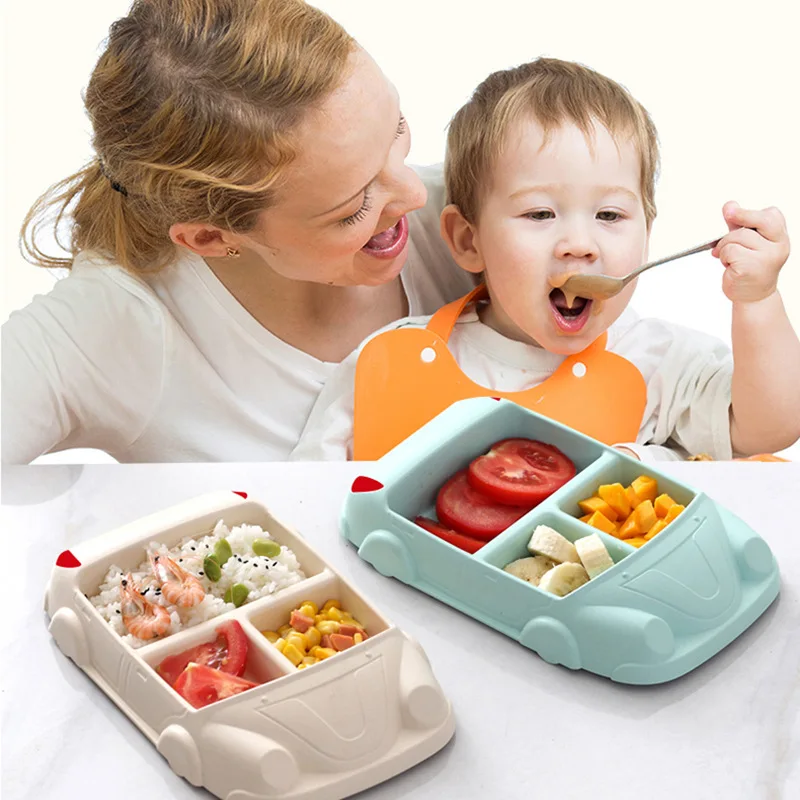 Babies can suck for a long time during the first weeks, when falling asleep, when they are sick, teething, in the presence of psychological discomfort, with difficulties in establishing emotional contact with their mother. Especially for a long time, babies suck in the morning - at this time, the mother's body actively produces the hormone prolactin, which is responsible for a sufficient amount of milk.
Babies can suck for a long time during the first weeks, when falling asleep, when they are sick, teething, in the presence of psychological discomfort, with difficulties in establishing emotional contact with their mother. Especially for a long time, babies suck in the morning - at this time, the mother's body actively produces the hormone prolactin, which is responsible for a sufficient amount of milk.
Do not take the breast until the baby has released it on its own. Otherwise, he runs the risk of not receiving something important from your milk, and the breast will not receive the “request” for the development of a new portion of precious nutrition.
Be patient, choose a comfortable position for feeding, make sure not to get bored in these moments (knit, listen to music, read, take a nap), and feed! For as long as the baby requires. Of course, there are exceptions: you need to open the door, go somewhere, do something... But these should be exceptions, not a regular practice.
The duration of feeding should be determined by the child himself, and not by minutes. I suggest to all mothers reading this text - do not count the application, do not notice their duration. Attach the child, as often as he asks. Having satiated, the child himself will “tear off” from the breast or stop sucking. The shape and size of the mammary glands and nipple, as well as the features of its structure, do not determine the amount of milk and the possibility of breastfeeding.
When a baby suckles, sensory impulses travel from the nipples to the mammary glands. In response to this, the anterior pituitary gland produces a hormone - prolactin. Prolactin enters the bloodstream of the mammary glands and stimulates the mammary secretory glands that produce milk. Thus, the more the baby suckles, the more milk is produced in the mammary glands. More prolactin is produced at night, so breastfeeding at night is especially beneficial for maintaining milk production.
How often do you need breast milk? The younger the child, the more of his needs are met by the composition of the milk.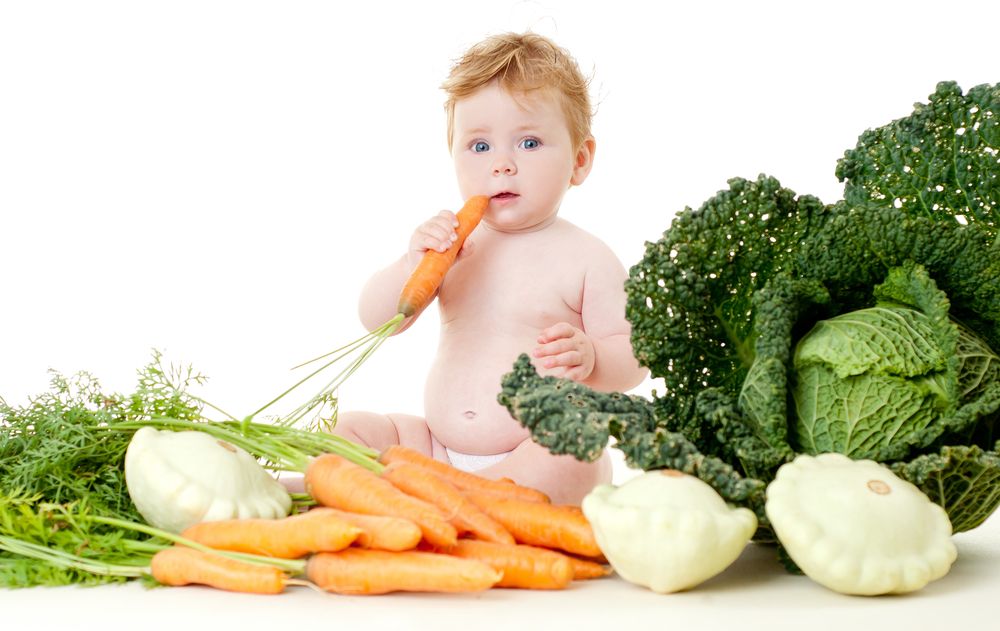 For example, a new portion of food helps a month-old baby to comfortably empty his intestines or get rid of the accumulation of gases, and a 5-6-month-old baby will cope with this without sucking. The grown-up little one, if he wants to caress his mother, will climb into her arms and hug her, and the baby knows one way to find deep and tender unity - to suck on his mother's breast. The smaller the child, the more often he asks for a breast, even 10-15 minutes after the previous feeding! The gastrointestinal tract of the baby is designed for round-the-clock supply of breast milk. The stomach itself rests almost all the time ”and does not participate in the digestion of milk - this is done by the intestines. Therefore, feed your baby often during the day and - which is especially important for producing enough milk - at least 3 times a night.
For example, a new portion of food helps a month-old baby to comfortably empty his intestines or get rid of the accumulation of gases, and a 5-6-month-old baby will cope with this without sucking. The grown-up little one, if he wants to caress his mother, will climb into her arms and hug her, and the baby knows one way to find deep and tender unity - to suck on his mother's breast. The smaller the child, the more often he asks for a breast, even 10-15 minutes after the previous feeding! The gastrointestinal tract of the baby is designed for round-the-clock supply of breast milk. The stomach itself rests almost all the time ”and does not participate in the digestion of milk - this is done by the intestines. Therefore, feed your baby often during the day and - which is especially important for producing enough milk - at least 3 times a night.
Usually a child of the first year of life requires up to 15-20 applications per day. After a year, their number can be reduced to 8-12. The baby, ready for weaning, sucks only 1-2 times a day.
Is long sucking bad for the breast?
One of the most important concepts in the organization of successful breastfeeding is CORRECT LETTING. The baby should capture the entire brown areola as deeply as possible. The radius of capture of the areola is 2-3 cm from the base of the nipple. The nipple itself is deep in the baby's mouth, without being at risk of injury.
The main criteria for the correct application:
- absence of soreness of the breast in the mother;
- certain external signs: at the time of sucking, the areola is practically invisible, the lips of the crumbs are turned outward, ensuring the tightness of the attachment (and the air does not enter the baby's stomach), the chin is pressed to the chest, and the cheeks and nose touch it.
Proper attachment protects the nipples from injury, and due to the effect of high-quality emptying of the mammary gland, it is the prevention of milk stagnation and mastitis. Try to teach your baby how to suckle correctly at the breast as early as possible! If it doesn't work out, use the help of consultants.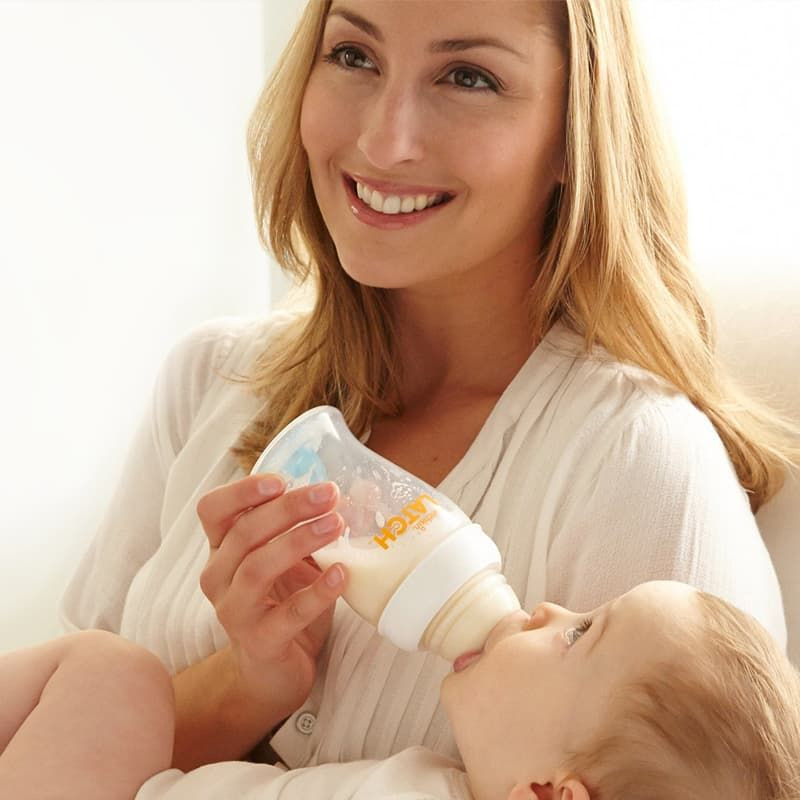
Only the composition of breast milk and the characteristics of the infant's digestive system are a harmonious mechanism for the formation of a high-quality biocenosis - and a healthy intestine is a healthy person!
How much energy does a baby need for growth and physical activity. Food sources of energy are fats, carbohydrates and proteins. According to the criterion of value, human milk proteins have the highest score. Breast milk contains predominantly whey proteins, l-lactoalbumin and lactoferrin are present in large quantities, which are sources of all essential amino acids (cow's milk contains b-lactoglobulin, which causes a negative antigenic reaction and has an allergenic property). In children of the first months of life, gastric juice has low acidity and enzyme activity - but they are enough to digest breast milk proteins.
Fats should provide the baby not only with energy, but also with essential fatty acids and fat-soluble vitamins A, D, E, K. It is fats that form the intelligence of the child.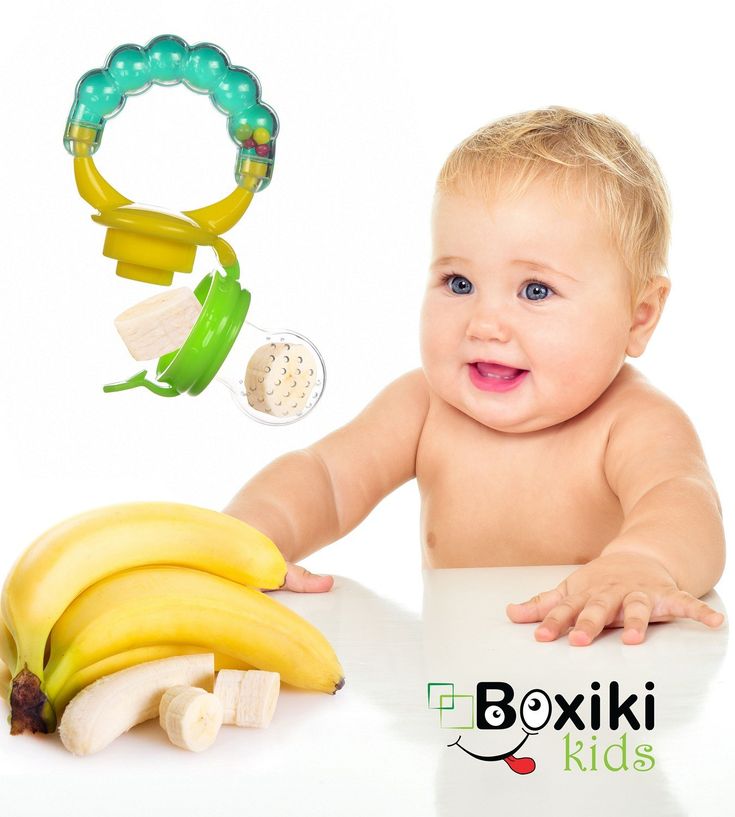 The ability of infants to synthesize many fatty acids is limited. But nature has provided that these acids are present in sufficient quantities in breast milk. Most artificial mixtures do not contain docosahexaenoic acid and, thus, when building phospholipids of nerve cells in the brain, the body uses other fatty acids, which can affect the level of mental and intellectual development of the child.
The ability of infants to synthesize many fatty acids is limited. But nature has provided that these acids are present in sufficient quantities in breast milk. Most artificial mixtures do not contain docosahexaenoic acid and, thus, when building phospholipids of nerve cells in the brain, the body uses other fatty acids, which can affect the level of mental and intellectual development of the child.
All carbohydrates are absorbed in the gastrointestinal tract in the form of monosaccharides (primarily glucose). Glucose is an indispensable source of energy for nervous tissue, the cells of which are not able to use fats as an energy source. Oligosaccharides determine the bifidogenic properties of breast milk.
It has long been known that human milk can provide maximum and comprehensive protection of the baby from possible infections. Breast milk contains all classes of immunoglobulins - A, M, O, E. Secretory Ig A (high content in colostrum) protects the intestinal epithelium from antigens in the intestinal cavity and actively stimulates the child's immune system. Lymphocytes and macrophages play an important role in the formation of antibacterial immunity in newborns. Lysozyme has bacteriostatic properties due to the enzymatic destruction of the cell membranes of microbial cells. Thus, secretory Ig A, lactoferrin, lysozyme form a powerful bacteriolytic system of human milk. With mother's milk, all protective antibodies are transmitted to the child, protecting against the implementation of specific infections. These substances are absent in mixtures and milk of animals.
Lymphocytes and macrophages play an important role in the formation of antibacterial immunity in newborns. Lysozyme has bacteriostatic properties due to the enzymatic destruction of the cell membranes of microbial cells. Thus, secretory Ig A, lactoferrin, lysozyme form a powerful bacteriolytic system of human milk. With mother's milk, all protective antibodies are transmitted to the child, protecting against the implementation of specific infections. These substances are absent in mixtures and milk of animals.
Breast milk contains specific hormones that promote more intense psychomotor and emotional development. Breastfeeding contributes to greater neurological stability, sociability, and memory development in children.
The correct bite, which is formed when covering the nipple, reduces the frequency of dental problems in early childhood, reduces the frequency of caries.
Psychological benefits of breastfeeding:
Breastfeeding defines a close emotional connection with the mother, which lasts for many years, creates a feeling of closeness and security in the child. A nursing woman causes a special tenderness of a loving man, paints the feeling of love in new bright colors, creates that specific climate in the family, when a man fully begins to feel his role as a protector of two inextricably linked and important people for him - mother and child!
A nursing woman causes a special tenderness of a loving man, paints the feeling of love in new bright colors, creates that specific climate in the family, when a man fully begins to feel his role as a protector of two inextricably linked and important people for him - mother and child!
The baby, who feels the native smell of the mother's breast, develops a deeper and more restful sleep. Reducing the frequency and severity of "intestinal colic" in breastfed children is associated with a faster development of microbiocenosis, maturation of gastrointestinal enzymes, and the formation of proper peristalsis against the background of calm and prolonged sucking.
The concept of "intestinal colic" is the condition of the child in the first 3 months of life. In newborns, the phenomenon is physiological and is associated with the immaturity of the regulation of motility and the immaturity of the enzyme system, which leads to an increase in gas formation and "bursting" of the intestine. In this regard, they can occur both with breastfeeding and with the use of mixtures. However, only breastfeeding can significantly reduce and alleviate the severity of the manifestations of pain in colic, due to greater ease of digestion and less gas formation. Many believe that "intestinal colic" is associated with intestinal dysbiosis or transient lactase deficiency. In a child of the first months of life, one can hardly speak of dysbacteriosis at all, since microbiocenosis is still being formed during this period. Breast milk has a high content of oligosaccharides, which are the most valuable probiotic factor contributing to the formation of bifidoflora. Its suppression (use of phages, abundance of biological preparations containing bifidobacteria) can contribute to the acquisition of dysbacteriosis. Thus, the study of feces for dysbacteriosis in children of the first months of life is not an informative method, since, on the one hand, changes will certainly be found in the analysis, on the other hand, the treatment of these changes can only lead to a deterioration in the formation of microbiocenosis.
In this regard, they can occur both with breastfeeding and with the use of mixtures. However, only breastfeeding can significantly reduce and alleviate the severity of the manifestations of pain in colic, due to greater ease of digestion and less gas formation. Many believe that "intestinal colic" is associated with intestinal dysbiosis or transient lactase deficiency. In a child of the first months of life, one can hardly speak of dysbacteriosis at all, since microbiocenosis is still being formed during this period. Breast milk has a high content of oligosaccharides, which are the most valuable probiotic factor contributing to the formation of bifidoflora. Its suppression (use of phages, abundance of biological preparations containing bifidobacteria) can contribute to the acquisition of dysbacteriosis. Thus, the study of feces for dysbacteriosis in children of the first months of life is not an informative method, since, on the one hand, changes will certainly be found in the analysis, on the other hand, the treatment of these changes can only lead to a deterioration in the formation of microbiocenosis.
But what about squeezing?
If you have organized feeding your baby in a natural way, there is no need for pumping. The mammary gland, responding to the “requests” and “requirements” from the child, produces as much milk as he needs. Frequent sucking with proper breast capture will insure against stagnation that occurs during feeding according to the regime scheme - when each breast is “idle” for 6-8 hours, waiting for its turn.
You need to pump only if the mother is separated from the baby, or works outside the home. In such cases, it is possible to create a "bank of one's own milk". (Frozen milk in bags can be stored for up to 6 months. In the refrigerator, we store expressed milk for up to 2 days. At room temperature for up to 12 hours)
How to do everything if you often breastfeed your baby?
To establish a life with a newborn, a young mother needs help with the housework. The main principle after childbirth: the mother takes care of the child, and others take care of the mother. Most household issues can be completely resolved without the participation of a nursing mother. It's not that hard to leave the laundry in the car, the preparation of quick-frozen foods, the shopping and the cleanliness of the house to the household. Moreover, everyone is interested in the baby growing up healthy, calm, not crying and not being capricious. For the sake of this, while the baby is small, it is worth spending most of the time on feeding - knowing that in the future the situation will change, the need for milk will be less and the mother will have more time. Many people are helped by the use of a sling-sling for carrying children, which allows, without taking the baby off the breast, to do simple household chores, moving freely around the apartment and beyond.
Most household issues can be completely resolved without the participation of a nursing mother. It's not that hard to leave the laundry in the car, the preparation of quick-frozen foods, the shopping and the cleanliness of the house to the household. Moreover, everyone is interested in the baby growing up healthy, calm, not crying and not being capricious. For the sake of this, while the baby is small, it is worth spending most of the time on feeding - knowing that in the future the situation will change, the need for milk will be less and the mother will have more time. Many people are helped by the use of a sling-sling for carrying children, which allows, without taking the baby off the breast, to do simple household chores, moving freely around the apartment and beyond.
Breast age of babies up to 2.5 years or more (and not up to 1 year as previously thought).
In the second year of life, the child receives from mother's milk fats, which are the main source of energy for the baby, all the immune cells that protect against seasonal infections and form a healthy immunity in your crumbs. The modern breastfeeding woman faces a lot of misinformation about breastfeeding, negative social pressures, and a host of other factors that undermine her decision and desire to breastfeed. And if the mother still, in spite of everything, continues to feed the child with her milk even after a year, she has to listen to all kinds of “horror stories” about the dangers of breastfeeding “big” children.
The modern breastfeeding woman faces a lot of misinformation about breastfeeding, negative social pressures, and a host of other factors that undermine her decision and desire to breastfeed. And if the mother still, in spite of everything, continues to feed the child with her milk even after a year, she has to listen to all kinds of “horror stories” about the dangers of breastfeeding “big” children.
This negative attitude is a direct legacy of the 20th century. A hundred years ago, no one was surprised that children receive their mother's milk until they are 2-3 years old. Our great-grandmothers remember that the process of lactation is the best contraceptive (the hormone prolactin, which is responsible for the production of milk, suppresses ovulation). But from the 30s to the 40s of the twentieth century, when the ideal of a woman was not a devoted wife and mother, but a shock worker of the labor front, there were less and less opportunities to feed a baby for a long time. In the middle of the last century, maternity leave was 1 month. The consequence of the lack of breastfeeding was the deterioration of the health of the younger generation. Health not only physical, but also mental; children who did not know their mother's breasts are more prone to depression, behavioral problems in adolescence and difficulties in establishing family life. That is why the World Health Organization began to pay close attention to breastfeeding. Numerous studies have been carried out on the composition of human milk, materials have been collected on the impact of breastfeeding on the development of a child, manuals for health workers and brochures for mothers have been written. Together with UNICEF (United Nations Children's Fund), the 10 Steps to Succeeding What Really?
The consequence of the lack of breastfeeding was the deterioration of the health of the younger generation. Health not only physical, but also mental; children who did not know their mother's breasts are more prone to depression, behavioral problems in adolescence and difficulties in establishing family life. That is why the World Health Organization began to pay close attention to breastfeeding. Numerous studies have been carried out on the composition of human milk, materials have been collected on the impact of breastfeeding on the development of a child, manuals for health workers and brochures for mothers have been written. Together with UNICEF (United Nations Children's Fund), the 10 Steps to Succeeding What Really?
The words that after a year there is nothing useful in women's milk is a myth.
The fat content of breast milk after a year of feeding increases by 2-3 times.
The amount of antibodies with the growth of the child is constantly increasing, as is the content of immunoglobulin A.
The level of substances responsible for the maturation of the gastrointestinal tract of the crumbs increases. In the second year of life, 448 ml of breast milk provides energy needs - by 29%, protein - by 43%. in calcium - by 36%, and the need for vitamin A - by 75%. Needs for folates (folic acid derivatives) are satisfied by 76%, in vitamin B12 - by 94%, and in vitamin C - by 60%. Other data show the effect of long-term feeding on IQ: the biggest gains were in the children who were fed the longest. A relationship was found between the duration of feeding and successful social adaptation at the age of 6-8 years, when the baby goes to school. Babies older than a year are less likely to suffer from allergic diseases. Their immunity is more stable, and in case of illness, the recovery period is shorter than that of their peers who do not receive mother's milk.
Reasons for reduced lactation:
- the baby is late attached to the breast (this is why the first attachment in the first hour after birth is important).

- violation of the technique of attachment to the breast. The sucking mechanism changes if the child has been taught to suck from a pacifier. And it's not about "easier" sucking, but about the technique of the relative position of the tongue, coverage of the lips and the inclusion of muscle groups of the bottom of the oral cavity, cheeks and perioral region, as well as the combination of sucking and swallowing reflexes. If a child technically begins to suck on the breast like a nipple, then this leads to the release of small portions of the "front" milk, stagnation of milk in the ducts, which can lead to lactostasis, as well as the formation of nipple cracks. In the latter case, the pain syndrome slows down both the synthesis of milk and its outflow from the ducts of the mammary glands.
- infrequent and short feedings. With effective breastfeeding, the baby receives all the milk he needs and does not require frequent (random) feeding, even with uneven intervals between feedings.
 If he requires feedings more than 1 hour later, it is likely that he is not properly attached to the breast or the duration of the feedings is so short that he does not have time to suck enough milk.
If he requires feedings more than 1 hour later, it is likely that he is not properly attached to the breast or the duration of the feedings is so short that he does not have time to suck enough milk. - lack of night feedings. The greatest secretion of prolactin occurs at night (prolactin is a hormone that stimulates milk production in the alveoli)
- use of objects simulating breasts (nipples and pacifiers). Sucking on the mother's breast is an innate reflex. The child is not designed by nature to suck anything other than the breast. And they always teach to a pacifier. In this case, the natural mechanisms of breast sucking are distorted. The experience of "nipple" sucking is formed. And always a pacifier is given in return for communicating with a child. Sucking on a pacifier can change the bite and affect speech development. Increased chance of breastfeeding. When suckling the breast, the child uses the tongue, which is important for the development of speech, receives more attention from the mother, which affects the psycho-emotional development of the child.

- supplementation and feeding. Child up to 6 months no other food or drink is needed other than breast milk. When the baby needs, offer him the breast, for any sucking of the baby, the breast will produce milk.
"All the best in a person comes from the rays of the sun and mother's milk"
(M. Gorky)
Dear mothers, feed your baby with breast milk, and you will give your child all the best that you can give to your tiny little man.
The impact of breastfeeding on a woman's health | Mamovedia
Everyone knows that breastfeeding is the best food for a child. Moreover, breastfeeding can also have a positive impact on the overall health of the breastfeeding mother. The most important advantage of breastfeeding is that it helps a woman recover faster after childbirth.
Many scientists around the world have conducted many studies that prove that breastfeeding significantly reduces the mother's risk of breast, uterine and ovarian cancer, cancer, stroke, and heart attack. In addition, breastfeeding helps reduce the risk of getting sick with a cold .
In addition, breastfeeding helps reduce the risk of getting sick with a cold .
Some women believe that breastfeeding does nothing but exhaust the body. In fact, breastfeeding is a normal continuation of the natural physiological process that began with conception and pregnancy.
Breastfeeding helps prevent postpartum haemorrhage in women. Many women who have had a positive breastfeeding experience report a positive and protective effect in the body from breastfeeding throughout most of their lives.
At the moment of putting the baby to the breast after childbirth, the woman's body produces the hormone oxytocin, which contributes to the effective contraction of the uterus. Over time, thanks to breastfeeding, a woman's uterus returns to its pre-pregnancy state. Unfortunately, those women who do not breastfeed their babies have a high risk of developing postpartum hemorrhage within a few days after giving birth.
In most cases, those women who actively breastfeed their babies do not have their periods. Thanks to this phenomenon, the mother has the opportunity to naturally delay the onset of the next pregnancy in the first six months after childbirth, and also effectively preserve iron in her body. In nursing mothers, it is very rare to find a state of iron deficiency anemia.
Thanks to this phenomenon, the mother has the opportunity to naturally delay the onset of the next pregnancy in the first six months after childbirth, and also effectively preserve iron in her body. In nursing mothers, it is very rare to find a state of iron deficiency anemia.
Many psychologists and specialists claim that breastfeeding has a positive effect on the metabolism in the female body, and also contributes to a good psychological state of the woman .
Not many people know that a woman who breastfeeds her baby has a higher chance of getting back in shape after pregnancy and childbirth, compared to those women whose baby is bottle-fed. In addition, non-breastfeeding mothers find it harder to maintain their weight in the future.
Breastfeeding not only helps a woman maintain a normal weight, but also significantly reduces her chances of developing diabetes and cardiovascular disease in the future.
Some new mothers mistakenly believe that breastfeeding leaches calcium from a woman's bones. In fact, it's the other way around. This is due to the fact that the content of calcium and phosphorus in the blood of lactating women is much higher compared to those who do not breastfeed. Lactation promotes active absorption of calcium and this leads to stronger bones and a reduced risk of osteoporosis.
In fact, it's the other way around. This is due to the fact that the content of calcium and phosphorus in the blood of lactating women is much higher compared to those who do not breastfeed. Lactation promotes active absorption of calcium and this leads to stronger bones and a reduced risk of osteoporosis.
From this we can conclude that breastfeeding significantly reduces the likelihood of occurrence and development of three serious and dangerous diseases in women, namely, female cancer, osteoporosis and heart disease. Moreover, while protecting a woman's body from diseases, breastfeeding does not have a noticeable negative impact on her health in general.
Breastfeeding has a positive effect on establishing an emotional bond between mother and baby, and also sets a special tone in their relationship. In addition, breastfeeding contributes to the regulation and balance of hormonal levels in women.
Thus, many facts and studies indicate that breastfeeding not only has a beneficial effect on a woman's body, but also on the soul.

